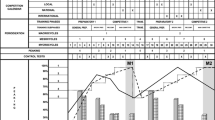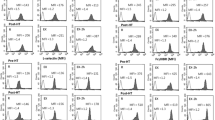Abstract
We performed this study to evaluate the chronic effect of training on neutrophil functions in humans. Twenty-six university students (14 males and 12 females) with a mean age of 19.1±0.8 years were divided into the athlete group and the control group based on answers given to a written questionnaire. The capacity of circulating neutrophils to ingest bacteria (phagocytosis) and to produce superoxide (nitroblue tetrazolium reduction) was measured under resting conditions in the absence of training activities. In addition, we measured hematological and serum biochemical parameters.
The present analyses revealed that the frequency of subjective symptoms concerning susceptibility to infections (sum of males and females) was higher in the athlete group than in the control group (p<0.05). In the investigation of males, hemoglobin and serum protein levels of the athlete group were lower than that of the control group (p<0.01, p<0.05, respectively). Although total and differential leukocyte counts, and phagocytic activity of neutrophils were not significantly different between the groups, superoxide productivity of neutrophils in the male athlete group was higher than that in the control group (p<0.05).
Since significant differences were observed in hemoglobin and serum protein levels in the male athletes, the training is considered to have been intense. An increase was noted in the neutrophil superoxide production along with these changes, but no significant difference was observed in the phagocytic activity. Therefore, there is the possibility of superoxide overproduction, which may lead to tissue damage.
Similar content being viewed by others
References
Shephard RJ, Verde TJ, Thomas SG, Shek P. Physical activity and the immune system. Can. J. Spt. Sci. 1991; 16: 163–185.
Pedersen BK. Influence of physical activity on the cellular immune system-mechanism of action. Int. J. Sports Med. 1991; 12: 23–29.
Pedersen BK, Rohde T, Zacho M. Immunity in athletes. J. Sports Med. Phys. Fitness 1996; 36: 236–245.
Ayabe M, Hara A, Shichijo S, Sagawa K, Yokoyama M. Immunological status of joggers. Bulletin of the Physical Fitness Research Institute 1988; 69: 1–7.
Pedersen BK, Tvede N, Christensen LD, Klarlund K, Kragbak S, Halkjr-Christensen J. Natural killar cell activity in peripheral blood of highly trained and untrained persons. Int. J. Sports Med. 1989; 10: 129–131.
Simon HB. The immunology of exercise. JAMA 1984; 252: 2735–2738.
Benoni G, Bellavite P, Adami A, Chirumbolo S, Lippi G, Brocco G, Giulini GM, Cuzzolin L. Changes in several neutrophil functions in basketball players before, during and after the sports season. Int. J. Sports Med. 1995; 16: 34–37.
Sato H, Suzuki K, Nakaji S, Sugawara K, Totsuka M, Sato K. Effects of acute endurance exercise and 8 week training on the production of reactive oxygen species from neutrophils in untrained men. Jpn. J. Hyg. 1998; 53: 431–440.
Mochizuki M, Suzuki K, Nakaji S, Sugawara K, Totsuka M, Sato K. Effects of maximal exercise on nonspecific immunity in athletes under trained and detrained conditions. Jpn. J. Phys. Fitness Sports Med. 1999; 48: 147–160.
Weiss SJ. Tissue destruction by neutrophils. New Engl. J. Med. 1989; 320: 365–376.
Digregorio KA, Cilento EV, Lantz RC. Measurement of superoxide release from pulmonary alveolar macrophages. Am. J. Physiol. 1987; 252: 677–683.
Suzuki K, Sato H, Kikuchi T, Abe T, Nakaji S, Sugawara K, Totsuka M, Sato K, Yamaya K. Capacity of circulating neutrophils to produce reactive oxygen species after exhaustive exercise. J. Appl. Physiol. 1996; 81: 1213–1222.
Tsukamoto K, Machida K, Ina Y, Kuriyama T, Suzuki K, Murayama R, Saiki C. Effects of crowding on immune functions in mice. Jpn. J. Hyg. 1994; 49: 827–836.
Borg AV. Psychophysical basis of perceived exertion. Med. Sci. Sports Exercise 1982; 14: 377–381.
Susuki K, Totsuka M, Nakaji S, Yamada M, Kudoh S, Liu Q, Sugawara K, Yamada K, Sato K. Endurance exercise causes interaction among stress hormones, cytokines, neutrophil dynamics and muscle damages. J. Appl. Physiol. 1999; 87: 1360–1367.
Holt ME, Ryall ME, Campbell AK. Albumin inhibits human polymorphonuclear leukocyte luminol-dependent chemiluminescence: evidence for oxygen radical scavenging. Br. J. Exp. Pathol. 1984; 65: 231–241.
Kumae T, Kawahara T, Uchiyama I. Effects of an endurance running on hematological properties and lymphocyte subpopulations. J. Phys. Fit. Nutr. Immunol. 1996; 6: 169–178.
Yoshimura H. Anemia during physical training (sports anemia). Nutrition Reviews 1970; 28: 251–253.
Poso AR, Nieminen M, Sankari S, Soveri T. Exercise-induced changes in blood composition of racing reindeer. Am. J. Physiol. 1994; 267: 1209–1216.
Haskell A, Nadel ER, Stachenfeld NS, Nagashima K, Mack GW. Transcapillary escape rate of albumin in humans during exercise-induced hypervolemia. J. Appl. Physiol. 1997; 83: 407–413.
Gleeson M, McDonald WA, Cripps AW, Pyne DB, Clancy RL, Fricer PA. The effect on immunity of long-term intensive training in elite swimmers. Clin. Exp. Immunol. 1995; 102: 210–216.
McHugh NA, Merrill GF, Powell SR. Estrogen diminishes postischemic hydroxyl radical production. Am. J. Physiol. 1998; 274: 1950–1954.
Author information
Authors and Affiliations
Rights and permissions
About this article
Cite this article
Tsukamoto, K., Suzuki, K. & Machida, K. Chronic effect of training on neutrophil functions in humans. Environ Health Prev Med 6, 22–26 (2001). https://doi.org/10.1007/BF02897305
Received:
Accepted:
Issue Date:
DOI: https://doi.org/10.1007/BF02897305




